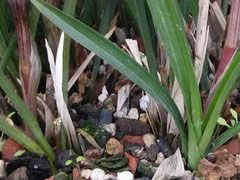August orchid cultivation points, edible fungi disease control
Key points of Orchid cultivation in August
First, this month has two seasons, the Beginning of Autumn (7th or 8th) and the End of Heat (23rd or 24th). The monthly average temperature is similar to that of the previous month, still about 29 °C. the weather is extremely hot, which is the second high temperature month of the year. The main work is still shading, and close curtains are still used when it is very hot. If the temperature is below 28 °C, sparse curtains can be used to prevent orchids from being exposed to direct sunlight. Indoor orchids pay attention to ventilation, heat prevention and cooling.
Second, the Beginning of Autumn after the air humidity decreased, water supply is very important, should be appropriate more watering, bearing in mind the ancients' warning not to dry in autumn. In particular, if there is no rain for a long time, we should pay attention to watering and moisturizing. If the humidity is too low, it can be sprayed to ensure the humidity of the orchid room, prevent the orchid leaves from withering and ensure the orchids thrive.
Third, after the orchid plant has gone through the high temperature and heat in summer, there is a great consumption of nutrients in the basin. Organic fertilizer should be applied to the root every 10 days, and the original solution of organic fertilizer should be insecticidal and sterilized before dilution, and foliar fertilization can be carried out alternately. Fertilization this month should appropriately increase the composition of phosphorus and potassium to facilitate the production of flower buds, and at the same time ensure the growth of autumn buds and the breeding of strong early spring buds, but should not apply thick fertilizer, and the time should still be carried out in the sunny evening when the plant material in the orchid pot is slightly dry and the temperature is lower than 30C. The next morning needs to be watered with soul water. (for matters needing attention in fertilization, please visit yxlhy.com for details.)
Fourth, when a typhoon strikes this month, it is necessary to do a good job in Taiwan prevention to prevent the typhoon from overturning the orchid basin and breaking the orchid leave. after the typhoon, there will be windless and hot weather, so it is necessary to repair the sunshade net damaged by the typhoon in time to prevent orchids from being burned by the scorching sun.
Fifth, the activity of bacteria and insects is very rampant this month, so it is necessary to do a good job in pest control and disease prevention. To cure insects, omethoate is used to kill shell insects, triclofenac is used to kill red spiders, and Mida is used to kill snails and slugs (carbofuran is ineffective). Should turn on the light less at night, because the light can induce insect moth to lay eggs, still can attract mole cricket, beetle to drill into the basin to do harm. This month is still a month with a high incidence of soft rot, stem rot, and other diseases, and sterilization must not be relaxed. Agricultural streptomycin, chlorothalonil, methyl thiophanate and other fungicides should be bombed in turn, not only to spray orchid leaves, but also to spray wine throughout Lanyuan. The work of disinfestation and sterilization is still carried out on a sunny evening when the sun is about to set.
Sixth, the autumn sun can enhance the rigidity of bluegrass, enhance the ability to resist diseases and insect pests, and enhance the ability to resist severe cold, so bluegrass after the Beginning of Autumn should gradually see more sunshine, but some should avoid the high temperature of autumn tigers, when the temperature drops below 28 °C. you can use a thin curtain to penetrate the light, and the sunshade net can be opened sooner or later.
7. Jianlan is in full bloom this month. after flowering, cut off the flower branches and replenish nutrients in time to the Zhuang orchid plant. at the same time, the orchid leaves are arranged and diseased leaves are cut off so as not to infect other orchid plants, and the dead leaves and scorched tail leaves must also be cut off to make the orchid plants bright and pleasing to the eye.
Eight, taboo: this month to change the basin, plant, introduction work is still not suitable, this month's ramet bluegrass wound is easy to infect bacteria, dangerous, and the old grass is easy to dump. (source: agricultural Expo Network)
- Prev

Orchids are several-year-old herbs.
Orchids have always been a necessary flower in many flower friends' homes. Some flower friends want to know that orchids are perennial herbs. The editor consulted some materials and sorted them out for flower friends' reference. In some materials, such as encyclopedia, the description of orchids is only epiphytic or terrestrial herbs, but we can according to the classification of herbs.
- Next

Fertilization techniques and methods of edible fungi and pollution-free control of orchid diseases and insect pests
Methods of pollution-free control of orchid diseases and insect pests
Related
- Is the orchid suitable for indoor use? Is it good for the body?
- How to prevent the empty root of orchids?
- What to do after the crab claw orchid is withered?
- Why are the leaves of orchids always yellow? Fertilizing and watering.
- Can the root of the gentleman orchid be saved if it is rotten?
- Diagnosis and treatment of cotton-blowing beetle insects in Cymbidium
- There is a way for a gentleman's orchid to rot.
- What is the most suitable temperature and humidity for the orchid?
- How to raise a gentleman's orchid? Cultivation techniques of Cymbidium
- How to prepare the nutritive soil for the cultivation of Cymbidium

